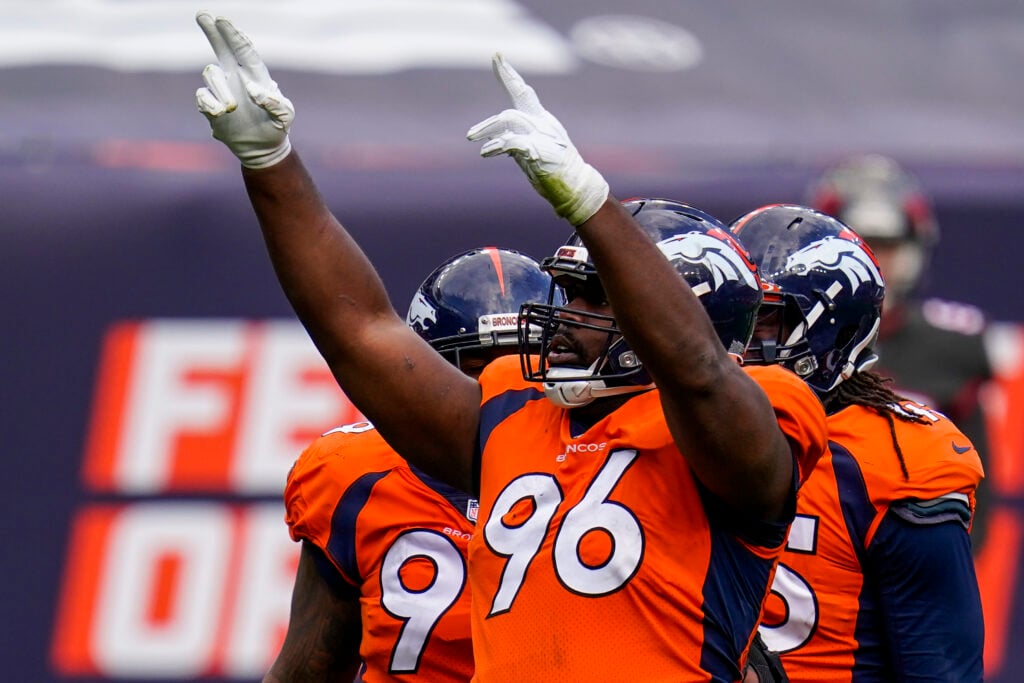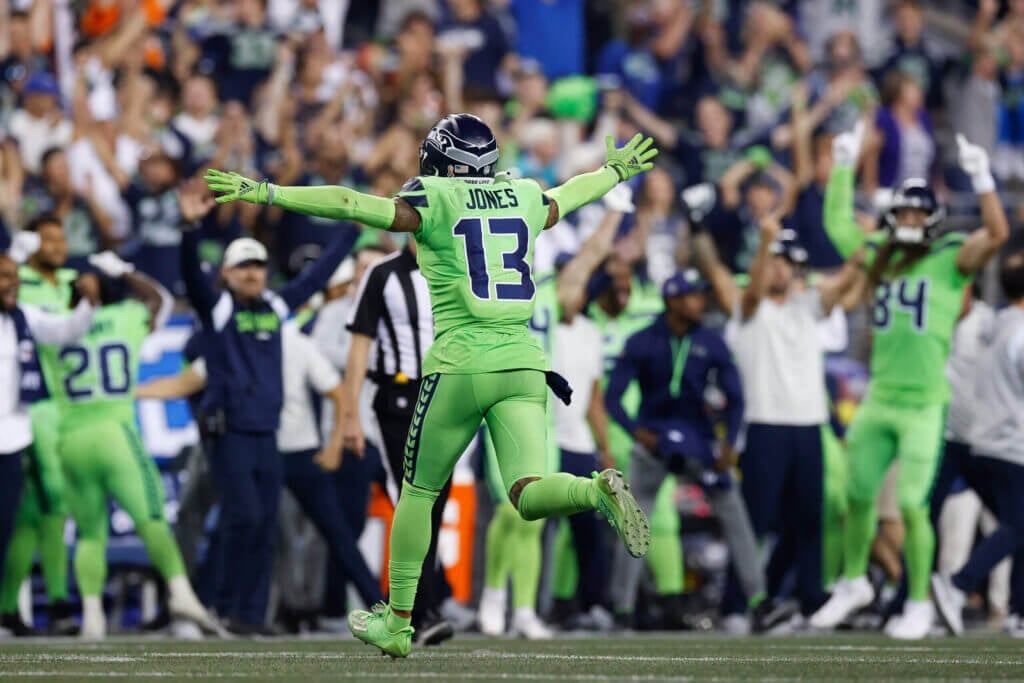RENTON, Wash. — The Seahawks’ defense is slowly making a dramatic midseason pivot. Again.
The 2020 Seahawks were one of the worst defenses in the league from Week 1 to Week 9. The unit was a disaster outside of its run defense. Quarterback pressures were few and far between. Opposing passing offenses were consistently prolific. Busted coverages were commonplace.
Advertisement
That season, everything came to a head during a 44-34 loss at Buffalo in Week 9. Josh Allen and the Bills embarrassed Seattle’s defense. Coach Pete Carroll said after the game he didn’t recognize his team.
Then from Week 10 to Week 17, Seattle had a top-10 defense by EPA per dropback, sack rate, net yards allowed per pass attempt and EPA per play, according to TruMedia (which is the source of all stats below, unless otherwise noted).
The 2021 Seahawks also came out the gate like one of the worst units in football, but things came to a head much sooner. After a defensive debacle in a 30-17 Week 3 loss at Minnesota, during which players bickered on the field and few were available to the media after the game, cornerback D.J. Reed said that the Vikings “schemed our ass up.” And he was right.
Notable changes at that point included benching cornerback Tre Flowers in favor of Sidney Jones, moving Reed from left to right cornerback and a tweak to the third-down package that inserted Ryan Neal into the lineup as a sixth defensive back, taking the place of inside linebacker Jordyn Brooks.
The numbers didn’t immediately shift, until rookie corner Tre Brown (who returned to practice this week, by the way) replaced Jones in Week 6. From Week 6 to Week 10, Seattle had a top-10 defense by EPA per play. Brown’s season-ending knee injury in Week 11 and Jamal Adams’ season-ending shoulder injury in Week 13 ended the run of top-10 play, but Seattle still ended the year much improved compared to its disastrous start.
Those awful starts in 2020 and 2021 are what made this season’s first five weeks so concerning. The stout run defense from the previous years had fallen apart, and to make matters worse, the Seahawks again had pass rush problems and issues defending the throwing game. From Week 1 to Week 5, Seattle had the worst pass defense in the league by EPA per dropback and allowed a league-high 170.2 rushing yards per game.

GO DEEPER
Scheme, personnel or both? What's wrong with the Seahawks' defense, and what can be fixed?
This year, a painfully bad performance against Taysom Hill and the Saints in Week 5 was the final straw. After that game, the locker room leaders held players-only meetings, allowed everyone to air their grievances, and then came to a consensus: The way they were playing was unacceptable.
“You get hit in the mouth a couple times, eventually you’ll hit back,” Brooks, one of those leaders, said after the win over the Chargers.
Advertisement
As a result, the last two games have signaled the beginning of another major midseason shift. Does it feel the same as the turnarounds they made in the previous two seasons?
“Yep,” Carroll said with a grin Wednesday before walking off the podium to end his news conference. “It does.”
How about that defense? 😏 pic.twitter.com/HwDyW1ghFm
— Seattle Seahawks (@Seahawks) October 25, 2022
Over the past two weeks, the Seahawks rank second in EPA per play (0.19), sixth in EPA per dropback (0.14) and fourth in EPA against the run (5.11) among teams that have played twice. Looking at traditional stats, the Seahawks rank fourth in yards allowed per pass attempt (5.85), fifth in third-down conversion rate (29.0), third in yards per play allowed (4.6), sixth in sack rate (9.3 percent) and seventh in rushing yards allowed per game (98.50) over that span.

GO DEEPER
'About time we took over': Embattled Seahawks defense dominates Kyler Murray, Cardinals
To trace the root of Seattle’s problems through the first five weeks, all one had to do was look up front. The same is true now that Seattle appears to be turning a corner.
The most notable change has come from defensive tackle Poona Ford, who has suddenly returned to form after a rough start to the season. The Seahawks expect Ford to be a playmaker, which he has been the past two weeks. He had a season-high five tackles and his first sacks of the year in the Week 6 win over Arizona, and he was again a force up front against Los Angeles.
Ford is better when he’s in attack mode, as illustrated by his contribution to the third-and-1 stop on the Chargers’ opening series. Ford flew off the ball and knocked back right guard Zion Johnson and slowed down Austin Ekeler just enough for Brooks to come and stop the runner short of the sticks. The Chargers turned it over on downs the next play. Ford also batted a Justin Herbert pass at the line, his second batted ball in as many weeks.
Advertisement
Fellow defensive tackle Shelby Harris has upped his game as well. By Week 5, Harris had just five pressures and one quarterback hit. In the last two games, Harris who has eight pressures, two quarterback hits, one sack, two batted passes — a specialty of his, as he had 25 in five seasons with the Broncos — and a tackle for loss in the run game against Los Angeles.
“Both have played more actively,” Carroll said Wednesday of Harris and Ford, the team’s starting interior linemen beside nose tackle Al Woods. “Both have been more forceful at the line of scrimmage; both have been pushing the pocket in the pass rush. You’ve seen both those guys knock balls down … that’s a huge factor. A DB jumps in front and knocks a ball down, seems like the greatest player ever; they knock a ball down and it’s the same thing. They’ve been really good about it.”

GO DEEPER
King of the swat: How Broncos’ Shelby Harris paces the NFL in batted balls
Carroll ended his response by saying: “They’ve been part of the change and the adjustment.”
The adjustment has been to alter the base alignment of the defensive tackles to maximize their ability to be aggressive at the point of attack. The Seahawks run a 3-4 base front, and typically that means deploying a nose tackle aligned head up over the center and two four-technique defensive tackles (lined up to the inside shoulders of the offensive tackles). In recent weeks, the Seahawks have been using three-technique looks, meaning their tackles are aligned to the outside shoulders of the offensive guards. This allows the front line to shoot gaps rather than read and react.
“It just lets us penetrate, and we’ve got the guys to do it,” said defensive tackle Quinton Jefferson, who has five pressures and two sacks over the past two weeks. “You see it’s like a totally whole new defense. Getting that penetration and guys can’t run the ball.”
Arizona’s two running backs had just 44 yards on 18 attempts. The Chargers’ three running backs combined for 31 yards on 12 carries. In the last two games, the Seahawks have allowed just one explosive run by a running back, and that was Ekeler’s 13-yard carry during what amounted to a two-minute situation in garbage time.
Stopping the run has put Seattle in more advantageous third-down situations. Through the first five weeks, Seattle’s opponents averaged 6.6 yards to move the sticks, the 13th-shortest distance in the league. In this two-game stretch, opponents have needed an average of 8 yards, the fifth-longest distance in the league. It’s not a coincidence Seattle’s third-down defense has dramatically improved.
Advertisement
Another factor in the third-down numbers is the re-emergence of Neal as an impact player in the team’s dime package. He had four plays on the ball Sunday. He intercepted Herbert on third-and-7 in the first quarter, swatted a potential touchdown out of receiver DeAndre Carter’s hands in the second, batted down a seam ball intended for tight end Gerald Everett in the fourth and deflected another would-be touchdown intended for receiver Jason Moore on the final drive of the game.
Tracked it all the way through.
📺 next up: #NYGvsSEA on FOX pic.twitter.com/BmPHp22cCx
— Seattle Seahawks (@Seahawks) October 25, 2022
Neal, a big safety or undersized linebacker who can rush the passer, defend the run and play deep coverage, is tied for the team lead in passes defensed with six. He’s Seattle’s only player with an interception and a sack this season and the only one with a tackle for no gain on a run play and a passing play. As was the case last season, Neal’s versatility is paying dividends and helping Seattle get off the field on third down.

GO DEEPER
Can underdogs Josh Jones, Ryan Neal keep Seattle's defense humming without Jamal Adams?
“It’s a huge benefit to us, playing the safety, playing the dime spot,” defensive coordinator Clint Hurtt said. “He can do so many different things for us. The more you can do, the more valuable you are. You make it also hard on the opponent. When you can line up in various different positions and perform that job at a high level, you can mess with peoples’ protections, how they identify the Mike in the run game — so many different things.
“When guys are in different locations, for us it’s simple; for the offense, it’s like, ‘Now we’ve got to reevaluate how we’re schematically doing things.’”
Is this new Seahawks’ defense here to say? This weekend will go a long way toward answering that question. The 6-1 New York Giants rank ninth in EPA per rush and average 173.3 rushing yards per game, second only to the Browns. Saquon Barkley is third among running backs in rushing yards per game (103.7) and is 10th in EPA per rush (min. 50 carries).
“This is the ultimate challenge,” Carroll said. “This is as good a running team as we’re going to ever go against. We’ll find out where we stand.”
As talented as Barkley is, Daniel Jones’ legs might present a bigger problem. Seattle has faced 45 snaps of QB runs, most in the NFL, and ranks 31th in EPA per snap on those plays. The Seahawks let Hill have a career day on the ground and surrendered 100 yards on 10 carries to Kyler Murray in Week 6.
Advertisement
“A lot of it is the run fits,” Hurtt said. “Things are different in terms of understanding your responsibilities in the fits and the different calls. Guys had to get comfortable with that.”
As a runner, Jones is fourth among QBs in attempts (58), second in scrambles (29), third in rushing yards (343) and second in rushing TDs (three). Murray and Baltimore’s Lamar Jackson are the only starting quarterbacks with more designed rushing yards than Jones (120), who is coming off a 107-yard day against Jacksonville that earned him NFC Offensive Player of the Week. Jones generates an explosive play on more than 17 percent of his runs, one of the best marks in the league.
“This kid, when he breaks runs, not a lot of people catch him,” Hurtt said. “Whatever his 40 time is, I don’t know, they made a mistake, somebody hit the button a little late. He doesn’t get caught a lot for a 4.7 guy.”
Hurtt feels his defense has made necessary strides to slow mobile quarterbacks. “But,” he said, “we’ve got a big challenge on Sunday.”
(Top photo of Ryan Neal: Jayne Kamin-Oncea / USA Today)

